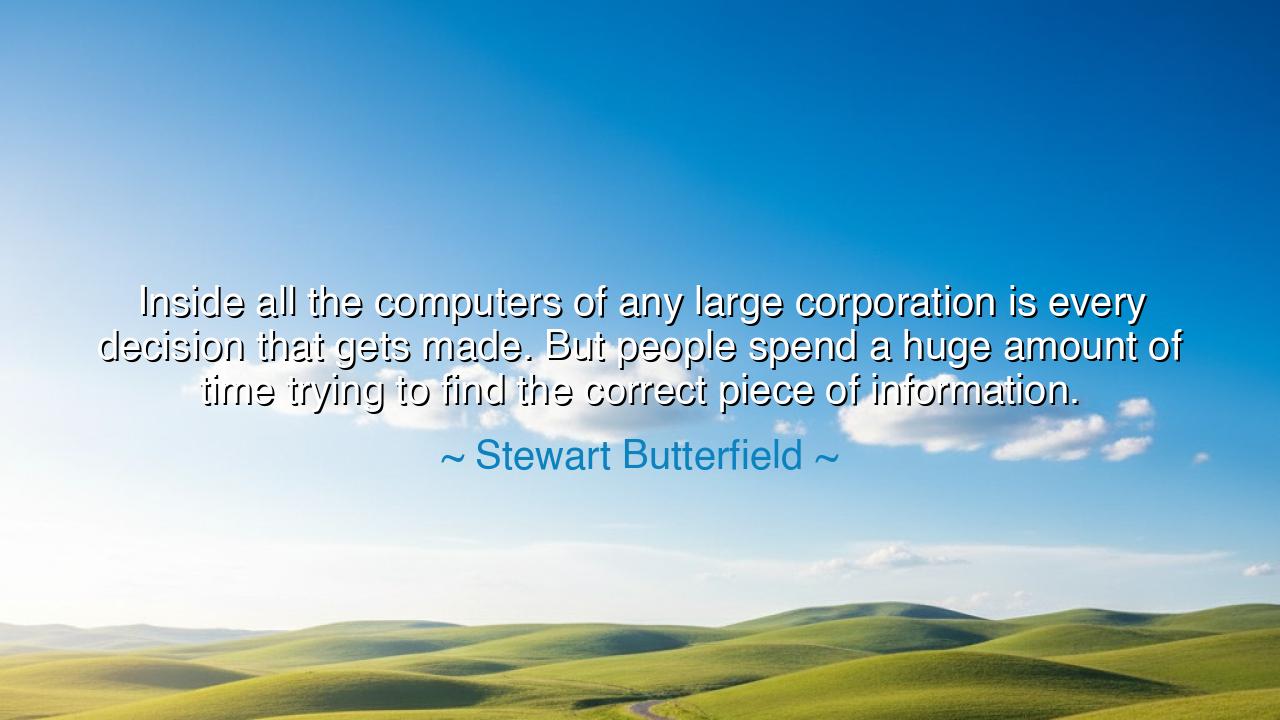
Inside all the computers of any large corporation is every
Inside all the computers of any large corporation is every decision that gets made. But people spend a huge amount of time trying to find the correct piece of information.






The modern sage Stewart Butterfield, founder of great endeavors in the realm of communication, once declared: “Inside all the computers of any large corporation is every decision that gets made. But people spend a huge amount of time trying to find the correct piece of information.” These words, though born in the digital age, carry the weight of an ancient truth. For in them we see not merely the lament of modern inefficiency, but a reflection of humanity’s eternal struggle—to turn chaos into order, to bring light to the labyrinth of knowledge, and to find wisdom within the endless sea of information.
In the beginning, man built computers to serve as his memory—to store what his mind could not hold, to preserve what might otherwise fade. But as the machines grew vast and powerful, they became like great libraries without librarians, vaults overflowing with treasure that no hand could easily reach. Butterfield speaks to this paradox: though every act, every word, every decision is recorded in the glowing chambers of our devices, still we wander lost, unable to summon the truth when it is needed. What use is knowledge, if it cannot be found? What power has data, if it cannot be understood?
This truth echoes even through the stories of the ancients. Consider the Library of Alexandria, the greatest collection of knowledge ever assembled by mortal hands. Within its walls lay the wisdom of centuries—the discoveries of philosophers, physicians, and poets. Yet when fire consumed it, humanity was cast into darkness, not because the knowledge did not exist, but because it was no longer accessible. The tragedy was not only in the burning of scrolls, but in the loss of the connections between them. So too do we, in the digital age, face a quieter fire—one not of flame, but of confusion. The knowledge remains, but its meaning is buried beneath layers of data, forgotten passwords, and unspoken context.
Butterfield, in his wisdom, saw this plight within the halls of modern corporations. He observed how every decision, every message, every record was locked within computers—machines humming with the stories of human effort. Yet the people who made those decisions often could not find what they had once known. Teams repeated work already done, questions were asked that had already been answered, and truth was lost not through malice, but through disarray. In this he recognized a greater lesson: that information alone does not create understanding. It is connection, not accumulation, that gives rise to wisdom.
There is something profoundly human in this struggle. The mind itself is like a corporation—filled with memories, decisions, emotions, and forgotten dreams. Within us too lies every record of our choices, yet we often cannot recall the one that matters most. Just as organizations lose themselves in complexity, so do individuals. The challenge of finding the correct piece of information mirrors the quest to find clarity within ourselves. The wise person must learn, as the great archivists of old once did, to order the chaos of the mind, to keep truth close, and to seek understanding rather than noise.
Let us look also to the story of Vannevar Bush, a visionary of the 20th century, who imagined the “Memex”—a device that could link all human knowledge through associative trails, much like the pathways of thought itself. His dream was not of storing infinite data, but of finding meaning through connection. It was a dream of harmony between man and machine, between memory and insight. Butterfield’s own work, in creating tools of collaboration, walks the same path—to bring unity where fragmentation reigns, to let knowledge flow freely between minds once divided.
The lesson, then, is clear: knowledge without structure is blindness. We must not only record, but organize; not only communicate, but connect. Whether in business, in study, or in the quiet reflection of one’s life, the task is the same—to bring order to the chaos of information, to shine the lamp of understanding upon the archives of the mind. Do not be content with knowing that something exists somewhere—seek to know it deeply, to make it living knowledge, accessible and useful.
Therefore, my child of the modern age, remember this: the machine holds much, but wisdom lies in how you use it. Organize your work with care, preserve your thoughts with intention, and never let your knowledge scatter like leaves in the wind. For in every computer, as in every soul, there is the sum of all decisions—but only those who learn to find and understand them will rule both their work and their destiny.






AAdministratorAdministrator
Welcome, honored guests. Please leave a comment, we will respond soon